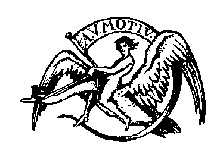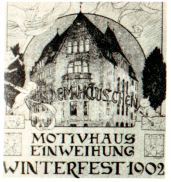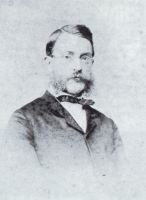genealogy
Index
Part 1
Part 2
Part 3
Part 4
Part 5
Part 6
Part 7
German
Audiofile
on this part
(German)
Engineering and poetry
"MOTIV", a studentīs association
Eight months of research in the worldīs longest cave - Max did not keep this experience to himself. We are quite sure about this. He must have shared it with his friends. If we want to know more about his motives we must have a look at his friends. Only there we may perhaps find answers to our questions.
We must learn more about Berlin at the turn of the century.
Max was member of a studentīs association named MOTIV, so the family tells us. The name sounds like a good omen to our attempt to find a plausible reason for his interest in speleology.
"MOTIV" still exists today, a small association of art-loving students of the Technical University in Berlin with two dozens of active members and a somewhat larger number of "old boys". Some years ago the first female students were admitted.
Archives do not exist any more. "Everything gone in the last war", regrets the chairman. Internet helps: In different libraries we can locate copies of some of the early annual reports of the association.
Gradually the academic world becomes alive in which Max lived before he set off for his journey to America.

MOTIV was at that time one of the large renowned student associations at the Technical University. Its curriculum was regarded as one-sides: In order to balance this it was thought it would be "best to waken the interest in all areas of human knowledge and ability" - so the common conviction. And therefore poems were written and theatre was played, students painted and made music.
 In Berlin at the turn of the century, MOTIV festivities were great social events with 1000 guests and more.
In 1902 the association moved to an impressive home in Charlottenburg
- today the former MOTIV house accommodates the "Renaissance Theatre".
In Berlin at the turn of the century, MOTIV festivities were great social events with 1000 guests and more.
In 1902 the association moved to an impressive home in Charlottenburg
- today the former MOTIV house accommodates the "Renaissance Theatre".
In Wuerzburg we discover some pages of music in an archive specialized on the history of student associations. Walter Luyken, Max's closest friend and brother of the admired Gerta, had contributed to the summer festival of its association a composition, a menuet for violin and piano. We show the notes to two musicians from Latvia, Nilss Silkalns and Terese Rozenberga. They find the piece interesting and perform it for us.
Mrs. Kaemper:
"I imagine Gerta now at the piano. And Max Kaemper plays the violin. A composition made by Gertaīs brother Walter. I imagine that the two had played this piece together. And when you play music together you have a close relationship to each other. And this is perhaps why he dedicated his discovery in the cave to Gerta. "
"There was no television and not many other diversions. They played music at home. They also composed music. This was part of their leisure activities; self-made music, not only listening. "
The ways of Max and Gerta separated because she had married another man during his America journey. But among the families of MOTIV members there were many other young ladies of marriagable age. The old gentlemen did not object if their daughters looked out for well suited husbands among MOTIV members - quite on the contrary. During a MOTIV party Max became acquainted with his later wife Elsbeth, the sister of a MOTIV brother.
Mrs. Kaemper:
"One day, on the tennis court, he asked her: "Are you still free?" and she answered: " Gladly, Mr. Kaemper ". But that was after the America journey "
MOTIV was a rather unpolitical association. Arts and social life were in the center of attention. There was no meddling with political issues, however harmless. But references to "patriotic enthusiasm" were a must in every one of their yearbooks. With special pride is was noted that a MOTIV delegation attended the ceremonies celebrating the 80th birthday of Bismarck, the former chancellor. The studentīs song for this jubilee had been composed by a MOTIV member - a fact which was to be reiterated in MOTIVīs annals for years to come.
A neighbour of the Kaemper family in the Grunewald was Alexander Conze, an archaeologist, who had become famous for his research on the Pergamon altar. The families were good friends. A photo shows the Kaempers and the Conzes playing cards, with Max and his sister Elizabeth as spectators. Max took this picture using an autorelease. Max's sister Anna later on married Conze junior.
The spectacular archaeological discoveries of the neighbour were certainly a frequent topic in the hospitable house of the Kaempers.
And there was cousin Karl, who could also tell exciting stories of his journeys of discovery. Karl Luyken, a distant relative of Max and also a MOTIV brother, was a member of the German Antarctic expedition from 1901 to 1903. On the Kerguelen he studied the magnetism of the Earth, by Imperial Order, under the most difficult conditions.
Mrs. Kaemper:
"All the Luyken cousins were very interested in the things around them. One of them made this South Pole trip /... / They all photographed and also processed their negatives. That was this time of fundamental change and they were very interested in everything, in these technical novelties. And also very talented in music. That was quite common in the family."
The interest in scientific research existed in the family. But what impact drove Max just into Mammoth Cave?
Coincidence helps us. A publication of the caver and local historian of Nuertingen, Hans Binder, comes on our desk. Its title is "The engineer and poet Max Eyth and his plan of Mammoth Cave of 1866".
 Max Eyth was an engineer who travelled all over the world
in the middle of the 19th century and wrote many books about it.
40 years before Max Kaemper he had visited Mammoth Cave.
Max Eyth was an engineer who travelled all over the world
in the middle of the 19th century and wrote many books about it.
40 years before Max Kaemper he had visited Mammoth Cave.
In his book "In the Current of our Time" , published in Berlin in 1905, Max Eyth described his experiences in Mammoth Cave.
Max Eyth was a prominent figure in Berlin at the beginning of the century. He had become famous as the founder of the German Agricultural Society and was highly esteemed among engineers. 1904 he gave a speech at the general meeting of the Association of German Engineers about "Engineering and poetry
"In Germany it is widely assumed that poetry and engineering are two spheres between which a contact is hardly conceivable.
The major part of the educated class is colour blind to the poetry of engineering.
The fact that a vase or an amphore can be beautiful is not denied. Nobody can indicate a good reason why in a similar way a machine - this device with an independent movement, with a certain independent existence - could be not beautiful as well. Technicians see this beauty. They see the beauty of a locomotive, of a machine tool sketched with technical taste.
The formation of taste in this sense is missing almost completely outside the world of experts, among the so-called educated people. Technicians may be patient of this phenomenon, because the future belongs to them. "
That was exactly how the members of "MOTIV" felt. Max Eyth was surely a sort of shining example to the young engineers who had gathered in MOTIV.
We point out this possible connection to the famliy and they check again their library. And indeed: Max Eyth's description of Mammoth Cave is there, and must have been there since Max Kaemperīs times. We do not have any doubt: Max Kaemperīs journey to America was a journey on the footsteps of his idol Max Eyth, the famous engineer and poet, whose travel descriptions led the young engineer finally to the largest cave of the world.